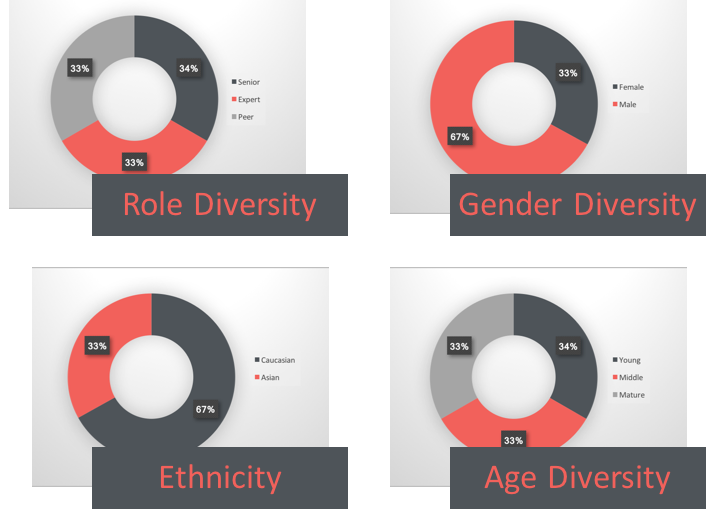
Some scholars suggest we’d do better not interviewing candidates at all.
Interviewing, as we know it today, isn’t an effective recruitment tool to select the best candidate from the rest.
Why?
- First impression bias- these are the judgements and opinions we make about people when we first meet them. Whilst these are mostly unrelated to job performance we wrongly convince ourselves, they are. For example he’s overweight so customers couldn’t relate to him, she’s pregnant so won’t have the stamina and so on.
- Lack of record keeping and standardised scoring during the interview process invites a concoction of biases. Once you’ve interviewed a couple of candidates it’s hard to keep track of who said what, so instead,
- we remember what stood out most (the Halo Effect)
- what we heard first or last (the Peak-end rule and Recency bias)
- we rely heavily on one piece of information or trait rather than the whole (the Anchoring Effect)
- we’re heavily influenced about how the information is presented (Framing eg “60% correct” draws a different conclusion than “40% incorrect”).
- Group think, where interviewers are influenced by each others opinions more than the capability of the applicant.
Despite all it’s shortcomings most of us couldn’t contemplate employing someone without interviewing them first.
So, if interviewing is here to stay, how can we improve it and what impact can we expect?
By adopting a Structured Interviewing framework you can double the validity of interviewing as an effective candidate selection technique.
To guide you through this process we’ve divided this “how to” guide into 3 phases- interview preparation, the interview and interview analysis.
Download this bonus for your free Structured Interviewing template as a companion to this guide.
[bonus]Free Bonus: [link]Click here to Download[/link] your Bonus[/bonus]
Interview Preparation
Hiring an employee is a big business decision and a costly one if you get it wrong (like this business did). So why allow hiring teams to come to interviews unprepared? Make it part of their KPI’s if necessary.
- Carefully select your interview team
Choose at least 2-3 interviewers to embrace a broader perspective. First think about what roles this job connects with in your business, invite someone senior, a technical expert (eg sales trainer for a sales role) and a peer that this role regularly interacts with (eg marketing manager, finance manager). Then if your business has sufficient people ensure a spread of demographic characteristics.
Here’s an example of the demographic profile of an interview panel for a sales consultant vacancy,

- Screen and shortlist for interview in an anonymised process using work skill tests
Use standardised tests to compare and rank candidates who have been anonymised. This the most powerful way to select the best candidate. Ask applicants to complete a series of work skill tests, which assess how capable they are to perform the key role duties. For more details see our ‘how to guide’ on the most effective ways to screen candidates.
- Be prepared with interview questions
Pre- set interview questions are a must. Don’t waste your time and money on interviews that amount to no more than an informal chat. Use the job description as a guide and focus on behavioural interview questions. Encourage interviewers to review questions prior to the interview date for greater engagement. If it’s a group interview, agree prior which interviewer will ask which question. Once this process is set up, you now have a bank of interview questions that can be used if the role is readvertised.
- Provide ideal answers with a grading scale
For each interview question provide an answer guide so each interviewer is aware of the type of response sought. Assign a score to each interview question for later marking and grading.
We suggest using the STAR answer guide whereby you actively encourage interviewees to provide answers to the behavioural questions using The STAR method where
S – Situation, background set the scene
T – Task or Target, specifics of what’s required, when, where, who,
A – Action, what you did, skills used, behaviours, characteristics
R – Result – Outcome, what happened?
- Prepare candidates for interview to reduce stress
All candidates suffer some degree of anxiety before an interview. Too much stress can badly influence interview performance. Overlooking such candidates may mean you miss out on top talent. Avoid this by proving candidates all relevant details – interview location, date, time, duration, format along with the name and position of the interviewers. Confirm all these details in an email so candidates can refer back to them.
The Interview
- Maintain interviewer independence
Either interview individually or enforce a ‘no discussion’ policy until all interviews are scored and submitted for final decision making. This prevents interviewers influencing each other.
- Ask questions in same order and stick to the same order for all candidates
Make the process the same for every candidate. We don’t set different assessments for students completing the same course, nor should we during the interview process. Remember we’re trying to compare candidates in order to select the best
- Keep the small talk, well, small
Often thought of as an ice-breaker to relax candidates, this can unfairly advantage some candidate over others. It’s also unfair to the business as this creates the unwanted chance of finding out how well the candidate relates to the interviewer not how well the candidate will perform the role. Remember the best person for the role isn’t the candidate that has most in common with the interviewer. Talk less, listen more. When it is time to talk, keep it professional and polite, not chummy.
- Score answers to each question, immediately and log comments
Each interviewer is required to score each question for each candidate. It’s important to do this immediately after the candidate has answered each question before moving onto the next question. You’ll get a much clearer and accurate view of each candidates capability compared to just providing an overall score at the end. Where possible it’s good to be able to compare the scores you assigned to previously interviewed candidates. Providing comments helps interviewers justify scores during the post interview analysis discussion.
Interview Analysis
- Submit scores to led evaluator and analyse
Develop a report card which includes
- Leader board of candidates interview score averaged across all interviewers, including comments.
- Include candidates score by each interviewer to examine interviewer score variability. Highly variable scores reflect a misalignment between interviewers which needs to be immediately addressed.
- For each question summarise the range of scores candidates achieved to identify questions that helped distinguish candidates from each other and those that didn’t. Update your interview questions to reflect this.
- Meet as a group to collaborate on who should receive the final offer
Armed with this information hiring teams have objective data at their finger tips to challenge each other to reach consensus on who should receive the final offer.
Don’t forget to download your free Structured Interviewing template as a companion to this guide.
[bonus]Free Bonus: [link]Click here to Download[/link] your Bonus[/bonus]
